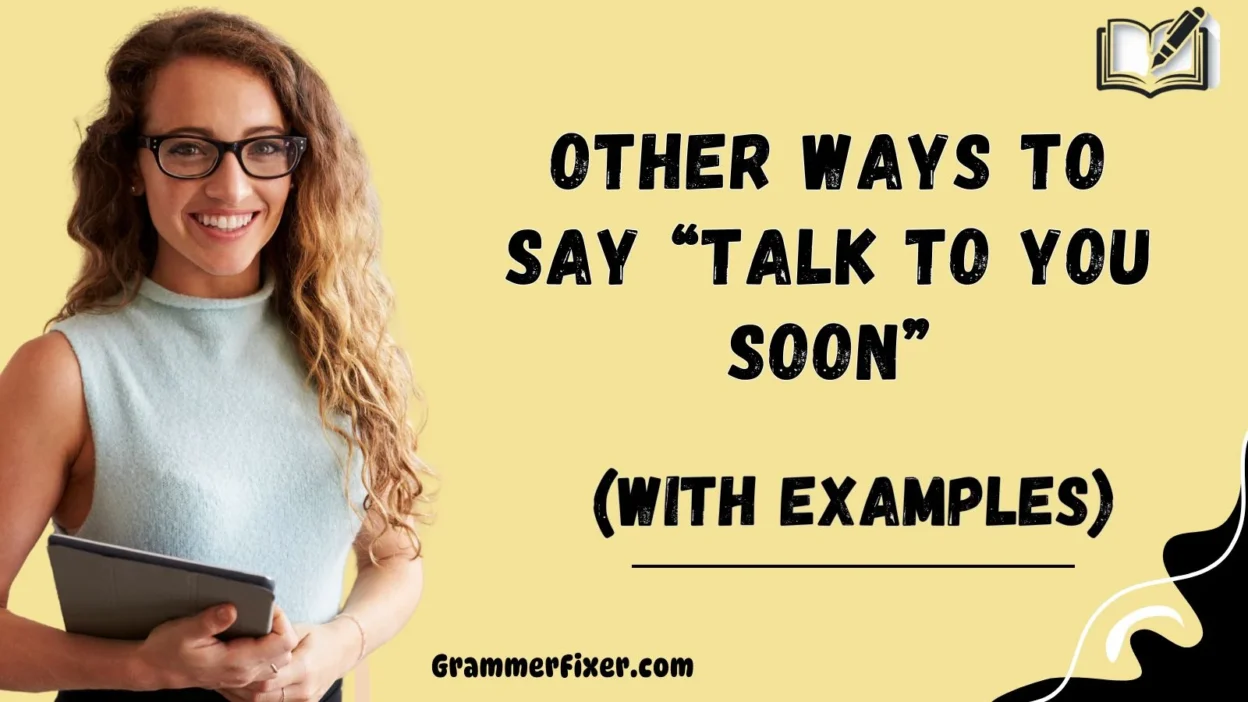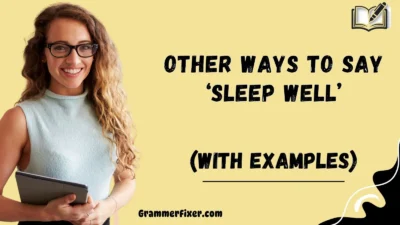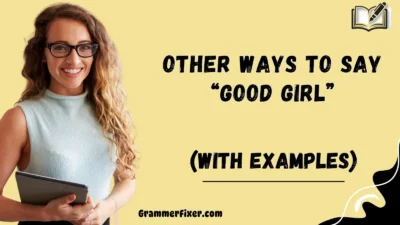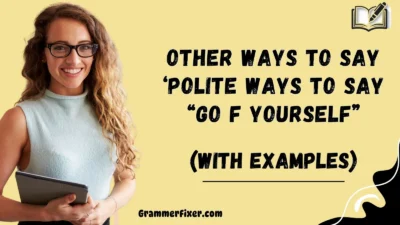Finding the right words to close a conversation can make a lasting impression. Instead of relying on the usual “Talk to You Soon,” you can choose alternatives that show warmth, sincerity, and thoughtfulness.
Whether you’re chatting with friends, colleagues, or clients, these phrases can help you express care, maintain professionalism, and make your goodbyes feel more personal and memorable.
What Does “Talk to You Soon” Mean?
The phrase “Talk to You Soon” is a friendly, conversational closing that implies you’ll reconnect in the near future. It shows a desire to continue communication, without specifying an exact time.
When to Use “Talk to You Soon”?
You can use this phrase in:
- Professional emails to colleagues, clients, or managers.
- Casual chats with friends and family.
- Networking exchanges when you want to leave the door open for future discussion.
Is It Professional/Polite to Say “Talk to You Soon”?
Yes. It’s professional, polite, and versatile. However, in very formal situations, you may want to use a more specific or polished alternative (e.g., “Looking forward to our next discussion”).
Pros or Cons of Saying “Talk to You Soon”
Pros:
- Friendly and approachable
- Professional yet casual enough for personal contexts
- Implies ongoing communication
Cons:
- Slightly vague (doesn’t specify when “soon” is)
- Can sound repetitive or autopilot-like if overused
1. Catch You Later
Meaning: A casual way to say goodbye that implies future contact.
Detailed Explanation: It’s informal and relaxed, often used among friends, teammates, or familiar colleagues.
Scenario Example: “Thanks for the update, Alex. Catch you later!”
Best Use: Casual conversations, coworkers you’re comfortable with.
Worst Use: Formal emails or high-level client interactions.
Tone: Friendly, laid-back, approachable.
2. Speak to You Again Soon
Meaning: A slightly more formal variation of “Talk to You Soon.”
Detailed Explanation: It indicates an intention to continue the dialogue soon, showing politeness.
Scenario Example: “I appreciate your input today, Ms. Thompson. I’ll speak to you again soon to finalize the details.”
Best Use: Professional emails, respectful settings.
Worst Use: Extremely casual, playful chats.
Tone: Polite, professional, respectful.
3. See You Around
Meaning: A friendly farewell that suggests you’ll meet again, though not necessarily planned.
Detailed Explanation: Common in casual settings; implies familiarity but not a fixed timeline.
Scenario Example: “It was great running into you, Mark. See you around!”
Best Use: Friends, classmates, colleagues in casual settings.
Worst Use: Business emails or formal correspondence.
Tone: Informal, relaxed, easygoing.
4. Keep in Touch
Meaning: Encourages ongoing communication beyond the current exchange.
Detailed Explanation: Shows you value the relationship and want to stay connected.
Scenario Example: “It was wonderful collaborating on this project, Jessica. Let’s keep in touch.”
Best Use: Networking, professional closings, friendships.
Worst Use: Short casual texts where a simple goodbye is enough.
Tone: Warm, thoughtful, encouraging.
5. I’ll Be in Touch
Meaning: A promise to initiate contact soon.
Detailed Explanation: Adds responsibility on the speaker to follow up, often in business contexts.
Scenario Example: “Thanks for your presentation, Robert. I’ll be in touch with the next steps.”
Best Use: Professional follow-ups, project management.
Worst Use: Overly casual chats, as it may sound formal.
Tone: Assured, proactive, responsible.
6. Let’s Connect Soon
Meaning: Suggests a future interaction, either professional or personal.
Detailed Explanation: Encourages further collaboration or catch-ups.
Scenario Example: “Great insights today, Elena. Let’s connect soon about the Q4 strategy.”
Best Use: Networking, professional discussions.
Worst Use: Very casual everyday chats.
Tone: Professional, collaborative, forward-looking.
7. Looking Forward to Our Next Chat
Meaning: Expresses anticipation for the next conversation.
Detailed Explanation: Shows enthusiasm and positivity about reconnecting.
Scenario Example: “Thanks for your feedback, Marcus. Looking forward to our next chat.”
Best Use: Work settings, client relations.
Worst Use: Too formal for short personal texts.
Tone: Warm, positive, enthusiastic.
8. Talk Soon
Meaning: A shortened, casual version of the original phrase.
Detailed Explanation: Simple, direct, and works in both professional and informal contexts.
Scenario Example: “Great progress today, team. Talk soon.”
Best Use: Emails, texts, team communication.
Worst Use: Extremely formal letters.
Tone: Direct, neutral, versatile.
9. Speak to You Shortly
Meaning: Indicates a very near-term follow-up.
Detailed Explanation: Adds certainty compared to “soon.”
Scenario Example: “I’ll review the draft and speak to you shortly, Anna.”
Best Use: Work settings with immediate tasks.
Worst Use: Casual conversations.
Tone: Professional, specific, reassuring.
10. Until Next Time
Meaning: Suggests a pause in communication until the next encounter.
Detailed Explanation: Slightly poetic and warm, suitable for meaningful closings.
Scenario Example: “It was wonderful catching up, Emily. Until next time.”
Best Use: Friends, thoughtful professional closings.
Worst Use: Urgent or task-based messages.
Tone: Gentle, thoughtful, warm.
11. We’ll Talk Again Soon
Meaning: A friendly assurance of continued dialogue.
Detailed Explanation: Stronger than “Talk to You Soon,” it emphasizes a certain future exchange rather than a possibility.
Scenario Example: “Great brainstorming session today, Lisa. We’ll talk again soon to refine the campaign details.”
Best Use: Workplace follow-ups, client communications.
Worst Use: Super casual texting—it may sound overly formal.
Tone: Reassuring, confident, slightly formal.
12. I Look Forward to Talking Again
Meaning: Expresses anticipation and eagerness to reconnect.
Detailed Explanation: More personal and heartfelt, it signals genuine interest in the ongoing conversation.
Scenario Example: “Thank you for sharing your ideas, Rachel. I look forward to talking again during the board review.”
Best Use: Professional networking, respectful conversations.
Worst Use: Casual, everyday texts with friends.
Tone: Optimistic, polite, warm.
13. Can’t Wait to Chat Again
Meaning: A more enthusiastic and playful alternative.
Detailed Explanation: Perfect for informal relationships, showing excitement to reconnect.
Scenario Example: “Loved catching up today, Maya. Can’t wait to chat again soon!”
Best Use: Friends, family, casual colleagues.
Worst Use: Professional emails—it may sound too informal.
Tone: Excited, lighthearted, cheerful.
14. Let’s Catch Up Soon
Meaning: Suggests a future conversation with an emphasis on updating each other.
Detailed Explanation: Implies sharing updates and maintaining connection, suitable for both personal and professional contexts.
Scenario Example: “It’s been a while, Chris. Let’s catch up soon over coffee.”
Best Use: Networking, casual work chats, friendships.
Worst Use: Strictly formal settings.
Tone: Friendly, inviting, approachable.
15. Talk to You Later
Meaning: A classic and casual farewell implying future contact.
Detailed Explanation: Commonly used in everyday conversations, but less specific than “soon.”
Scenario Example: “Thanks for helping with the slides, Nina. Talk to you later.”
Best Use: Casual conversations, coworkers.
Worst Use: Very formal letters or presentations.
Tone: Familiar, relaxed, casual.
16. Until We Speak Again
Meaning: A slightly poetic and reflective alternative.
Detailed Explanation: Adds a sense of warmth and significance, often used in personal or thoughtful exchanges.
Scenario Example: “I really appreciated our talk today, Mr. Anderson. Until we speak again, take care.”
Best Use: Thoughtful professional closings, family or friends.
Worst Use: Short workplace updates.
Tone: Warm, reflective, meaningful.
17. I’ll Reach Out Soon
Meaning: Indicates that you’ll be the one to initiate contact in the near future.
Detailed Explanation: A proactive and professional phrase, often used in business follow-ups.
Scenario Example: “Thanks for your insights, David. I’ll reach out soon with the updated project timeline.”
Best Use: Work emails, networking, client relations.
Worst Use: Informal texts among friends.
Tone: Responsible, professional, proactive.
18. Let’s Stay in Touch
Meaning: Encourages long-term communication beyond just one conversation.
Detailed Explanation: Often used after networking events or meetings to ensure continuity.
Scenario Example: “It was great meeting you at the summit, Nathan. Let’s stay in touch.”
Best Use: Networking, conferences, professional introductions.
Worst Use: Short-term or one-off meetings where no future contact is expected.
Tone: Friendly, professional, open.
19. You’ll Hear From Me Soon
Meaning: A confident assurance that you’ll follow up.
Detailed Explanation: Stronger than “I’ll be in touch,” as it sets clear expectations of communication.
Scenario Example: “Thank you for your contributions, Jessica. You’ll hear from me soon with feedback.”
Best Use: Business updates, client follow-ups.
Worst Use: Informal settings—it may feel stiff.
Tone: Assertive, professional, clear.
20. Let’s Talk Again Soon
Meaning: A slightly more direct and collaborative twist on the original phrase.
Detailed Explanation: Encourages a shared responsibility to reconnect, not just one-sided follow-up.
Scenario Example: “Great work on the proposal draft, Jennifer. Let’s talk again soon to finalize.”
Best Use: Work collaboration, professional teamwork.
Worst Use: Very casual conversations with friends.
Tone: Collaborative, professional, straightforward.
21. I’ll Check In Soon
Meaning: Implies that you’ll reconnect to follow up or see how things are going.
Detailed Explanation: Often used in professional or caring contexts, showing responsibility and attentiveness.
Scenario Example: “Thanks for the update, Michael. I’ll check in soon to see the team’s progress.”
Best Use: Work updates, mentoring, client relations.
Worst Use: Random casual chats (too formal).
Tone: Caring, responsible, professional.
22. Let’s Reconnect Soon
Meaning: Suggests a future conversation to re-establish contact.
Detailed Explanation: Warm and slightly formal, it’s a great way to show intentionality about staying in touch.
Scenario Example: “It’s been too long, Victoria. Let’s reconnect soon and discuss the new market research.”
Best Use: Networking, rekindling professional or personal connections.
Worst Use: Casual goodbyes among close friends.
Tone: Warm, thoughtful, professional.
23. I’ll Talk to You Shortly
Meaning: A near-immediate alternative to “soon.”
Detailed Explanation: Stronger and more specific, it conveys that contact will happen in a very short time frame.
Scenario Example: “I’ll review the numbers and talk to you shortly, Christopher.”
Best Use: Urgent work communications.
Worst Use: Informal family/friend chats—it may sound too formal.
Tone: Clear, professional, assertive.
24. Hope to Talk Again Soon
Meaning: Adds a sense of polite hopefulness about future conversations.
Detailed Explanation: Slightly softer than “Let’s talk again soon,” making it ideal when you’re not certain about timing.
Scenario Example: “It was nice meeting you at the conference, Patricia. Hope to talk again soon.”
Best Use: Networking, polite closings, acquaintances.
Worst Use: Close family and friends (sounds distant).
Tone: Respectful, polite, cautious.
25. I’ll Be in Contact
Meaning: A professional, assured statement about future communication.
Detailed Explanation: Often used in business or client follow-ups, emphasizing responsibility.
Scenario Example: “Thank you for today’s meeting, Elena. I’ll be in contact with the Q4 updates.”
Best Use: Work settings, proposals, follow-ups.
Worst Use: Very casual chats—it may sound stiff.
Tone: Formal, professional, direct.
26. Let’s Touch Base Soon
Meaning: A business phrase for reconnecting briefly to update each other.
Detailed Explanation: Common in corporate settings, it suggests a quick status check-in.
Scenario Example: “Good work on the drafts, Anna. Let’s touch base soon on the next phase.”
Best Use: Corporate emails, meetings, teamwork.
Worst Use: Casual conversations (too businesslike).
Tone: Professional, concise, corporate.
27. Looking Forward to Our Next Conversation
Meaning: Shows enthusiasm and anticipation for a meaningful exchange.
Detailed Explanation: A warmer, more formal variation of “Talk to You Soon.”
Scenario Example: “I really appreciated your insights, Dr. Martinez. Looking forward to our next conversation.”
Best Use: Client meetings, professional networking, formal interactions.
Worst Use: Casual short texts.
Tone: Warm, professional, respectful.
28. I’ll Reach Out Again Soon
Meaning: A follow-up assurance that you’ll initiate contact soon.
Detailed Explanation: Adds clarity that you’ll be the one taking the next step.
Scenario Example: “Thanks for sharing your concepts, Isabella. I’ll reach out again soon with revisions.”
Best Use: Client relations, project management, business updates.
Worst Use: Casual texts—it may feel unnecessarily formal.
Tone: Professional, responsible, clear.
29. Until We Meet Again
Meaning: A gentle, heartfelt farewell that implies another meeting is certain.
Detailed Explanation: More personal than businesslike, it’s often used in meaningful connections.
Scenario Example: “It was wonderful seeing you, Claire. Until we meet again, stay safe.”
Best Use: Friends, family, warm closings.
Worst Use: Strictly professional emails.
Tone: Warm, caring, heartfelt.
30. Stay in Touch
Meaning: Encourages ongoing communication, very similar to “Keep in touch.”
Detailed Explanation: A versatile closing that works across professional and personal contexts.
Scenario Example: “Great collaborating with you, Daniel. Stay in touch as the project moves forward.”
Best Use: Networking, business partnerships, friendships.
Worst Use: One-off interactions with no future intent.
Tone: Friendly, professional, open.
Conclusion
The phrase “Talk to You Soon” is simple, versatile, and warm—but relying on it too often can make your messages feel predictable or repetitive. By exploring these 30 alternatives, you can adjust your communication to fit the tone, relationship, and context of each interaction.



